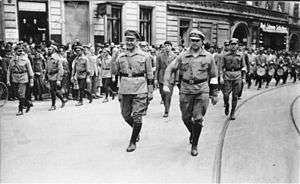Willy Leow

Willy Leow (born January 25, 1887 in Brandenburg an der Havel; died October 3, 1937 in the Soviet Union) was a German artisan (carpenter) and politician of the Communist Party of Germany.
Life and work
Willy Leow attended elementary school in Brandenburg an der Havel. Then he learned the carpentry trade and was taught at the Workers' Educational School in Berlin. In January 1904 Leow became a member of the German Wood Workers Association. In the same year Leow joined the Social Democratic Party (SPD), to which he belonged to 1916. After Leow had participated in 1917 in the foundation of the Spartacus League and briefly belonged to the Independent Social Democratic Party of Germany (USPD), he was in the end of 1918 a founding member of the Communist Party og Germany (KPD).
1925 Leow was elected the Second Chairman of the Roter Frontkämpferbund (RFB), founded in 1924, the defense and protection organization of the KPD. In 1928 Leow was elected to the Reichstag, where he remained until 1933. Later SPD politician Herbert Wehner, who was himself a communist in the Weimar period wrote decades later in his memoirs, Leow was "a thoroughly corrupt person".[1]
After the Nazi seizure of power Leow fled abroad. From 1935 he lived in the Soviet Union. He worked as an editor and head of the German state publishing house in the Volga German Autonomous Soviet Socialist Republic. In 1936, he was arrested during the Stalinist purges and sentenced on October 3, 1937 for organizing a Trotskyist-terrorist group in the Military Collegium of the Supreme Court of the USSR to death and was shot.[2]
Post mortem
In the history of the German Democratic Republic Leow was in the first decades after his death a so-called Damnatio Memoriae, that means, he was concealed deliberately in the history of the GDR and in the public culture of remembrance of the East German state: His person was deliberately not mentioned and traces of its existence have been systematically eliminated from publicated documents and image reproductions of the GDR. So Leow was for example out retouched of a widely printed photograph that showed him next to Ernst Thälmann during a RFB march in the 1920s. The reason for this practice was that the arrest and murder Leows (before fascism of German Communists and refugees) by the Soviet sister state did not fit into the historical picture of the GDR, and therefore in his publications were not allowed to occur.[3]
References
- ↑ Herbert Wehner: Zeugnis, 1982, S. 79.
- ↑ Ulla Plener, Natalia Mussienko (Hrsg): Verurteilt zur Höchststrafe: Tod durch Erschießen. Todesopfer aus Deutschland und deutscher Nationalität im Großen Terror in der Sowjetunion 1937/1938. Reihe: Texte/Rosa-Luxemburg-Stiftung, Bd. 27. Dietz, Berlin. 2006. S. 58
- ↑ Walter Hütter: Bilder die Lügen. Begleitbuch zur Ausstellung der Stiftung Haus der Geschichte der Bundesrepublik Deutschland, Bonn 2000.
Literature
- Leow, Willy. Bundesstifung Aufarbeitung Berlin
| Wikimedia Commons has media related to Willy Leow. |